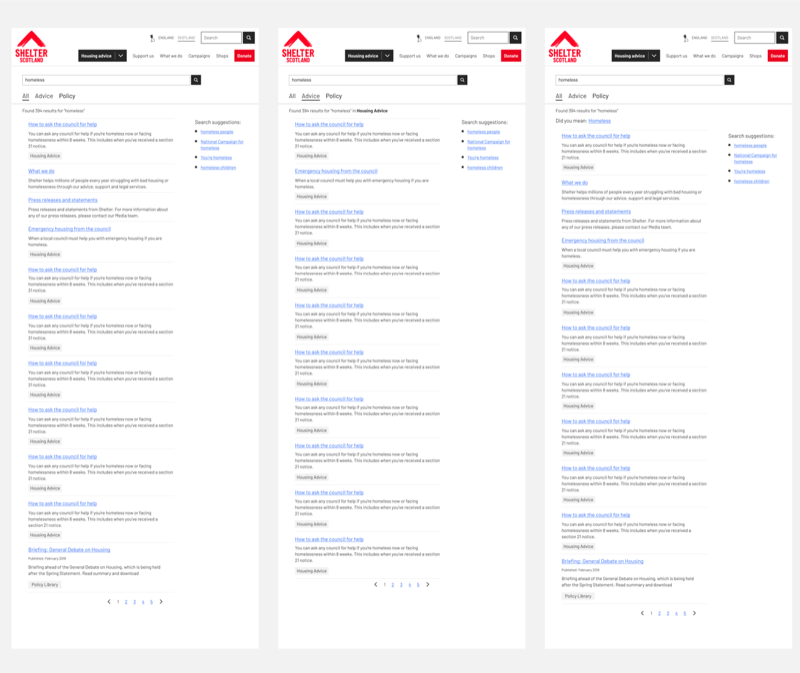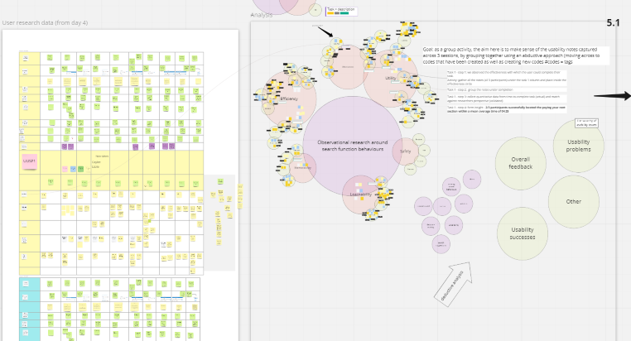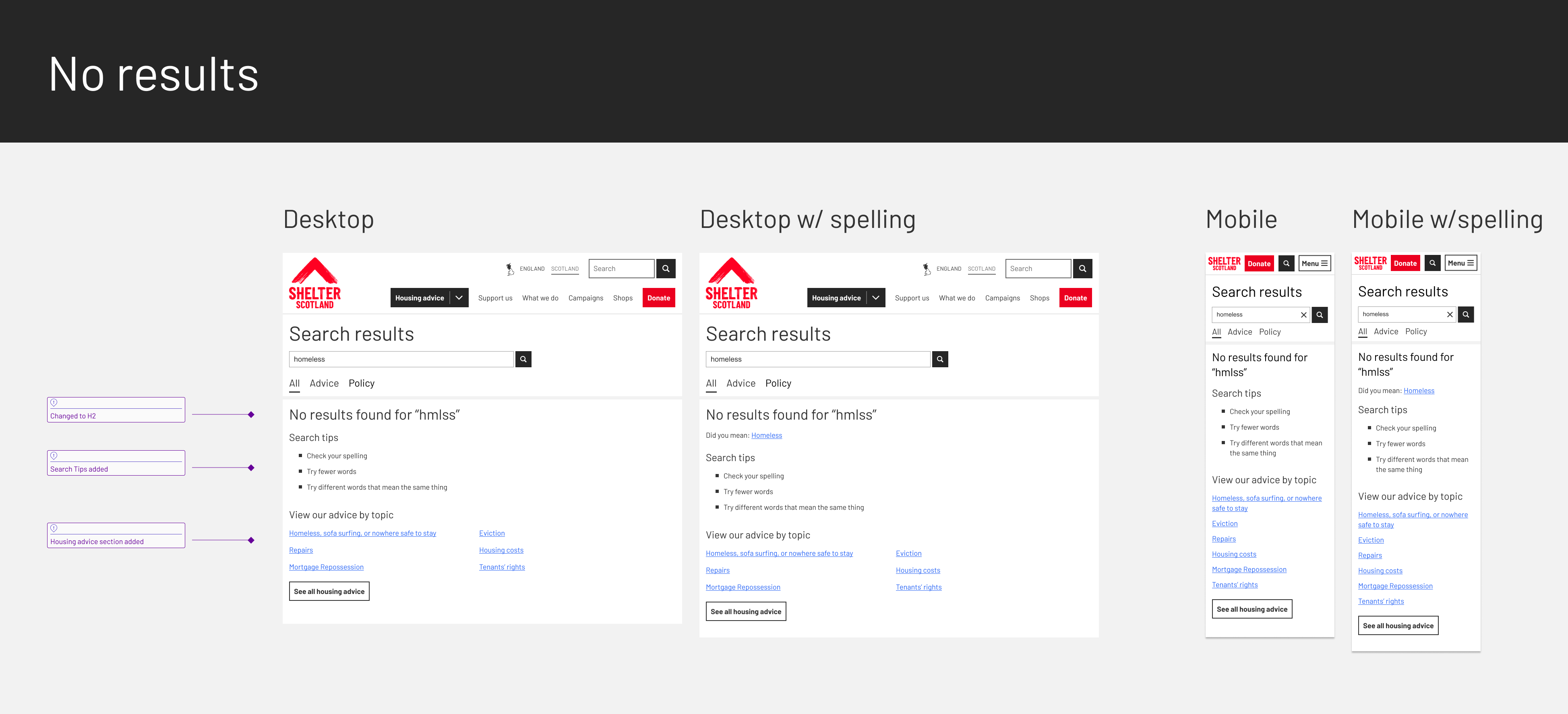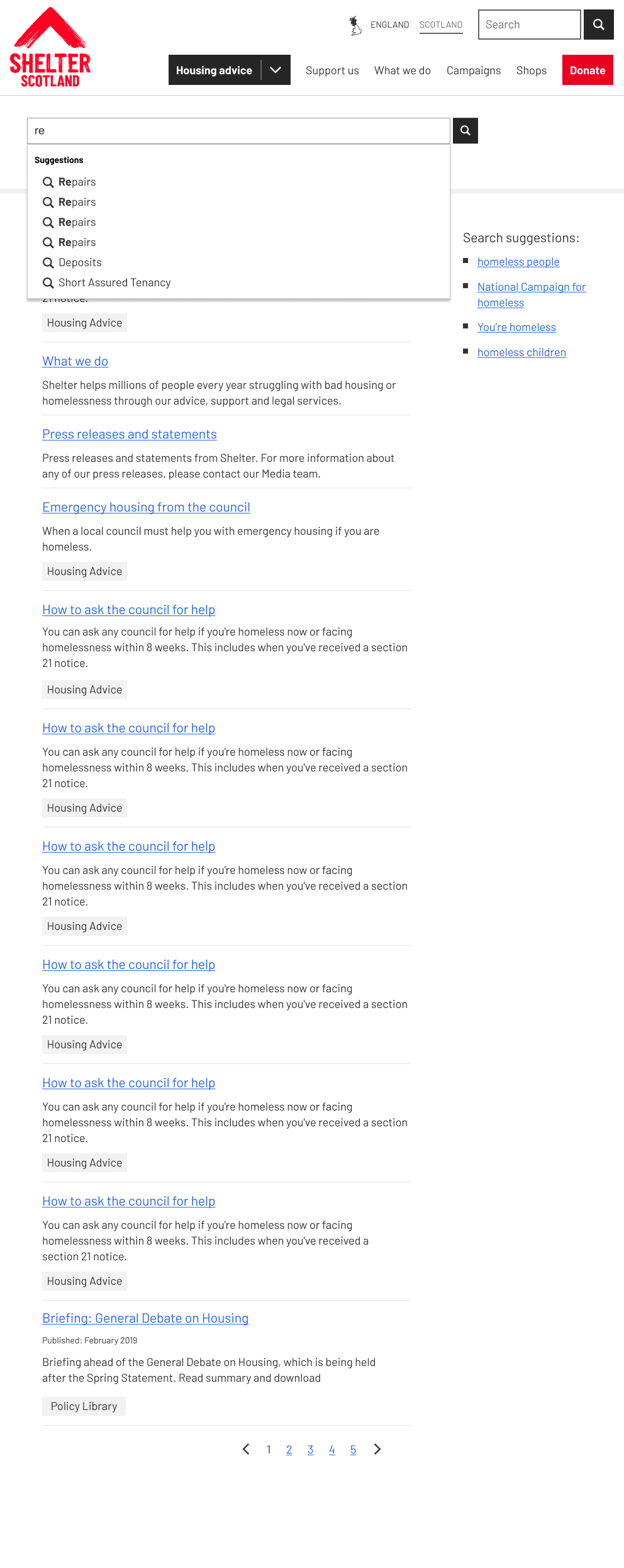Search Improvements
Crisis-informed digital transformation
Overview
This project was commissioned after Shelter's central digital team identified search inefficiencies through research credits, revealing that failed searches were driving vulnerable users to contact the helpline unnecessarily. I was asked to take ownership of the project and lead the comprehensive redesign of the search system for Shelter Scotland, with successful implementation later influencing adoption across the wider Shelter network.
I joined as UX Designer leading the end-to-end design process for a system serving users in housing crisis situations. My role focused on transforming user insights into technical improvements while coordinating stakeholder relationships across development and content teams.
My Role & Impact
- Led end-to-end design process from problem analysis through implementation
- Developed trauma-informed research methodology using proxy users and analytics to protect vulnerable users
- Coordinated closely with lead developer to understand technical constraints and prioritise implementation phases
- Delivered measurable outcomes including 90% task completion improvement and 25% reduction in search refinements
- Influenced organisational adoption across wider Shelter network through demonstrated success

The Challenge
The existing search system wasn't designed for people in crisis. Users encountering housing terminology for the first time, dealing with stress about losing their homes, and primarily using mobile phones during emergencies couldn't find the advice they desperately needed.
Working closely with the lead developer, I learned about the technical constraints and possibilities. This helped me prioritise improvements that could deliver immediate value while building towards bigger system changes.
The key problems: people couldn't spell crisis-specific housing terms they'd never seen before, didn't know the right search terms for complex legal issues, and kept landing on pages written for lawyers instead of people seeking help.
henResearch and Discovery
The project began with existing research indicating that zero-result searches were contributing to increased helpline calls. I took ownership of deeper investigation, focusing on understanding the specific challenges faced by users in housing crisis situations.
Recognising the trauma-informed approach necessary for this vulnerable user base, I designed a research methodology using proxy users combined with comprehensive analytics analysis and screen recording review through Hotjar. This approach enabled us to understand user behaviour without subjecting vulnerable users to additional stress during housing emergencies.
Working closely with the lead developer, I analysed misspelled search reports to identify patterns specific to housing terminology. Collaborating with a web content editor, I systematically reviewed these files to uncover common misspellings of housing-specific terms that weren't being caught by the backend search system, as well as errors in specific letter correspondence numbers related to housing and eviction processes.
Key Research Findings
I conducted systematic analysis of search patterns using affinity mapping to transform scattered user data into actionable insights. The critical finding was that users in housing crisis struggled with crisis-specific terminology they were encountering for the first time.
Key insights:
- Users couldn't spell crisis-specific housing terms they'd never seen before
- Search terminology confusion led to failed searches and helpline calls
- Mobile users saw very few results above the fold, compounding accessibility challenges
- Users frequently landed on legal pages designed for professionals rather than advice seekers

Problem Definition and Strategy
How do we provide immediate search improvements that work for users in crisis while demonstrating technical feasibility for organisational adoption?
I worked with the lead developer to establish a two-phase implementation strategy. The developer guided me through backend possibilities, identifying improvements that could be implemented without significant design support for phase one, versus changes requiring more intensive design work for phase two.
I prioritised technical improvements for phase one: enhanced spelling suggestions incorporating housing-specific synonyms, improved search result ordering, and backend algorithm refinements. For phase two, I planned the more complex UX improvements including autocomplete functionality, result categorisation tabs, and mobile optimisation.
This phased approach proved essential when I discovered that implementation would need to demonstrate success on Shelter Scotland before gaining support from the wider Shelter organisation, which was initially resistant to change.
Search System Transformation
The redesigned search system addressed crisis user needs through four key technical innovations, with enhanced content categorization helping users distinguish advice from legal information throughout:
Crisis-Specific Spell Check
Enhanced suggestions understood housing terminology users encountered for the first time during emergencies.
Intelligent Autocomplete
Real-time suggestions helped users find the right terms when they didn't know the correct housing terminology.
Mobile-First Results
Optimized result display ensured users could see relevant information above the fold on mobile devices.
Separate Legal Search
Dedicated pathway for professional legal content prevented users seeking advice from accessing complex legal documents.
Testing Strategy and Validation
Baseline Assessment
I conducted moderated usability testing with 5 participants to establish performance benchmarks. This revealed specific pain points including inadequate spell-checking, unclear search terminology, and poor result relevance.
Key insights
- Inadequate spell-checking for housing terms
- Users couldn't find appropriate search terms
- Poor result relevance and mobile visibility
Development Testing
I led design development in Figma while maintaining close collaboration with the lead developer throughout implementation. For validation, I implemented trauma-informed testing using proxy users rather than directly engaging vulnerable users in crisis situations.
Key findings
- Close developer collaboration essential for success
- Proxy user testing protected vulnerable users
- Design iterations validated through analytics
Pre-Launch Validation
Final usability testing with 5 participants on both mobile and desktop devices showed that 9 out of 10 participants completed tasks more quickly and landed on correct pages compared to the original system.
Key outcomes
- 90% of users completed tasks faster
- Better results on first try across devices
- Ready for organisational pilot launch
Technical Implementation
Working with developers, I advocated for improvements including enhanced spelling suggestions with housing-specific synonyms, autocomplete functionality, result categorisation showing content source, mobile optimisation with tabbed results above the fold, and separation of legal content into dedicated search.
I established success criteria that valued task completion improvement and reduced user frustration, recognising that effective search serves users in crisis situations who need immediate, accurate information.
Zero Results Transformation
Converting search failures into helpful guidance for vulnerable users

Launch and Coordination
I secured senior stakeholder support for implementation on Shelter Scotland, positioning the project as a pilot that could demonstrate value before wider organisational adoption. This strategic approach proved effective when the wider Shelter site was initially resistant to implementing our recommendations.
The Scotland implementation included all proposed improvements, requiring coordination between design, development, and content teams to ensure seamless integration with existing site architecture.

Live Implementation
The enhanced search system successfully launched on Shelter Scotland, demonstrating crisis-informed design effectiveness. Users could find housing advice through improved spell-checking, autocomplete functionality, and mobile-optimized result display with clear content categorization.
Results and Impact
The implemented search system delivered measurable improvements across all key metrics: average search depth decreased by 0.22, search refinements decreased by over 3%, and bounce rates decreased by over 1%. Most significantly, 90% of users in post-implementation testing completed tasks more quickly than before.
Organisational influence: After reporting on our analytics success, the wider Shelter site adopted several of our design recommendations including search suggestions, autocomplete, and result categorisation. While they didn't implement the mobile tab system or legal content separation, the demonstrated success influenced their broader UX strategy.
Strategic Insights
Crisis-informed design methodology
This project demonstrated that designing for users under extreme stress requires adapted research approaches that prioritise user wellbeing while still gathering actionable insights. The trauma-informed methodology became a template for future vulnerable user research.
Technical collaboration for accessibility
Working closely with developers to understand backend constraints enabled strategic prioritisation that delivered immediate user value. The housing-specific terminology integration showed how domain expertise can inform technical solutions.
Organisational change through demonstration
The phased implementation approach proved that demonstrating success on a smaller scale can drive wider organisational adoption. Sometimes the most strategic decision is proving value before seeking broader change.